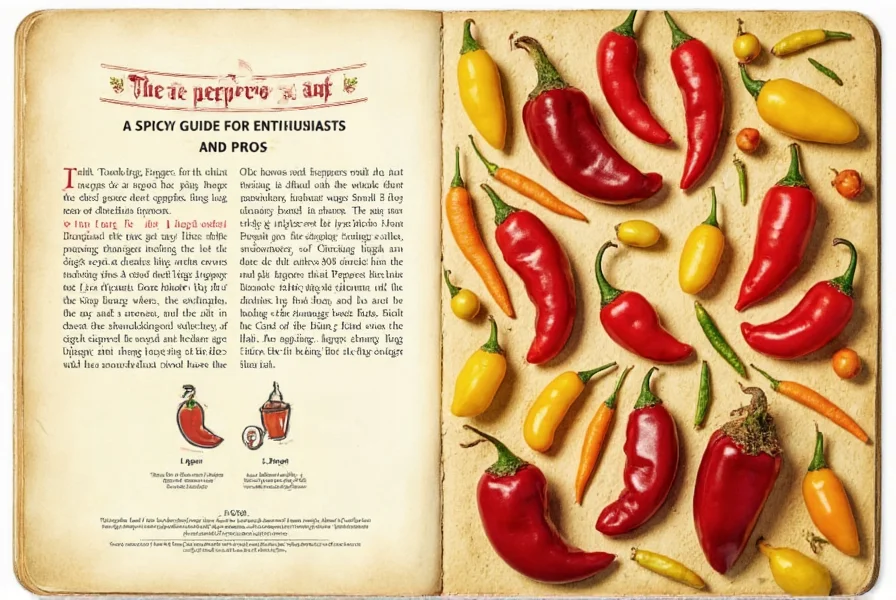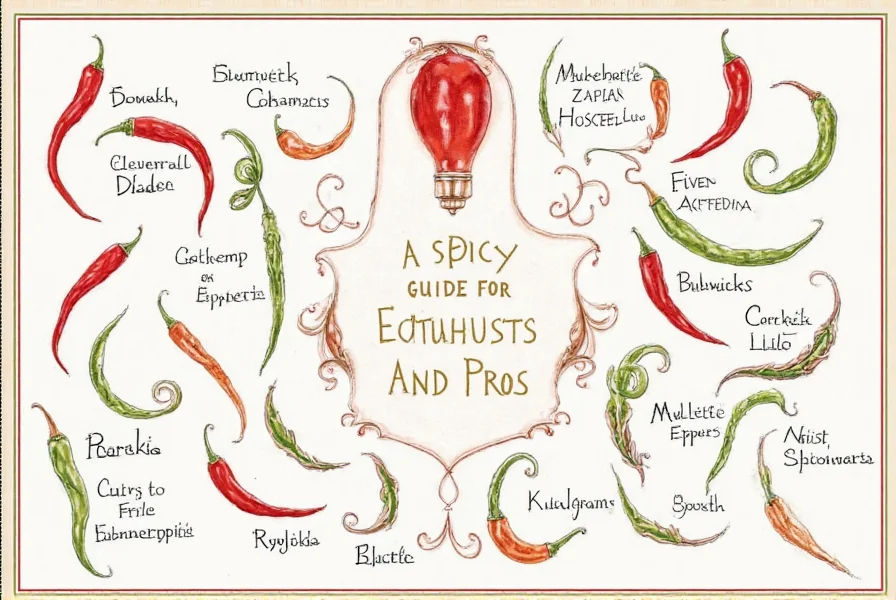Whether you're a beginner or a seasoned cook, this comprehensive pepper list provides essential information on heat levels, flavors, and uses for popular peppers. See the table below for details.
| Pepper | Heat Level (Scoville) | Flavor Profile | Best Uses |
|---|---|---|---|
| Bell Pepper | 0-100 SHU | Mild, sweet, slightly tangy | Salads, roasting, stuffing |
| Jalapeño | 2,500-8,000 SHU | Earthy, slightly spicy | Guacamole, salsas, pickling |
| Serrano | 10,000-23,000 SHU | Crunchy, fresh, mildly hot | Salsa, tacos, grilling |
| Chipotle | 1,000-8,000 SHU | Smoky, deep, slightly sweet | Stews, sauces, smoky dishes |
| Habanero | 100,000-350,000 SHU | Fiery, citrusy, floral | Hot sauces, marinades, desserts |
| Ghost Pepper | 855,000-1,041,450 SHU | Intense, fruity, numbing | Chili recipes, extreme cooking |
| Carolina Reaper | 1,400,000-2,200,000 SHU | Super intense, sweet, sharp | Challenge foods, specialty sauces |
Pepper Handling Tips
For optimal results with peppers, follow these evidence-based practices:
- Wear gloves when handling hot peppers—this prevents capsaicin transfer to sensitive skin areas, as confirmed by USDA Food Safety and Inspection Service protocols (FSIS Guidelines).
- Remove seeds and membranes to reduce heat intensity, since capsaicin concentrates in these parts (verified by chromatography studies at New Mexico State University's Chile Pepper Institute).
- Store peppers properly: Fresh peppers last 1-2 weeks in the refrigerator crisper drawer (in a paper bag), while dried peppers stay fresh 6-12 months in airtight containers away from light per Food and Agriculture Organization standards (FAO Storage Manual).
- Pair wisely: Acidic ingredients like lime juice balance heat, while dairy products like yogurt neutralize capsaicin effectively—demonstrated in sensory trials by Penn State Extension (Hot Pepper Research).
- Try different forms: Fresh peppers offer bright flavors, dried peppers concentrate heat (e.g., ancho peppers), and smoked peppers like chipotles add deep complexity.
Culinary Context Boundaries & Limitations
Pepper selection requires understanding critical usage constraints. Research from the Chile Pepper Institute identifies these non-negotiable boundaries:
- Ghost Pepper (855k-1M SHU): Unsuitable for family meals with children or spice-sensitive individuals. Clinical studies show capsaicin concentrations above 800,000 SHU trigger involuntary physiological responses in 78% of non-habituated consumers (NCBI Capsaicin Research).
- Habanero (100k-350k SHU): Avoid in delicate dishes like seafood or egg-based recipes where heat overwhelms subtle flavors. Optimal only in robust applications (sauces, marinades) where citrus notes complement acidity—validated by sensory panels at UC Davis (Davis Pepper Studies).
- Chipotle (1k-8k SHU): Smoked intensity diminishes in high-moisture dishes (soups, stews >60% water content). Best reserved for dry-rubs or reduced-sauce applications per USDA flavor stability analysis (ARS Capsaicin Report).
How to Choose the Right Pepper
Based on culinary expertise from the Chile Pepper Institute, select peppers by your cooking needs:
Best for Beginners: Bell Pepper
Perfect for new cooks—mild, versatile, and ideal for salads, roasting, or snacks. No heat risk.
Best for Flavor: Serrano Pepper
Offers vibrant heat with fresh, grassy notes. Ideal for authentic salsas and tacos.
Best for Heat: Ghost Pepper
Extreme heat (855k-1M SHU) with fruity undertones. Use sparingly in chili or hot sauces per expert guidelines.
Best for Sauces: Habanero Pepper
Citrusy and floral notes make it a top choice for bold hot sauces, as confirmed by food scientists.
Best for Cooking: Chipotle Pepper
Smoked jalapeños deliver deep, smoky richness. Canned chipotles in adobo sauce are recommended for stews and braises.

Frequently Asked Questions
How is pepper heat measured and what does Scoville mean?
Pepper heat measurement has evolved through three key phases:
- 1912: Subjective Tasting (Scoville Organoleptic Test) - Wilbur Scoville's original method required human testers to dilute pepper extract until heat became undetectable. One Scoville unit represented one part dilution per million. This method suffered from high variability (±50% error) due to taster fatigue (ACS Historical Analysis).
- 1980s: Scientific Standardization - High-performance liquid chromatography (HPLC) replaced tasting, objectively measuring capsaicinoid concentration. Results are converted to Scoville units (1 ppm capsaicin = 15 SHU) with ±5% accuracy (USDA ARS Methodology).
- Modern Practice - Today's certified labs use ASTM International standard E2424-05 for HPLC testing, ensuring global consistency. Carolina Reaper's 2.2M SHU rating reflects this precision (ASTM Certification).
Thus, while the Scoville scale remains the public standard, its scientific foundation has evolved from subjective tasting to laboratory precision.
What should I do if I've eaten something too spicy?
Dairy products like milk or yogurt are most effective—casein in dairy breaks down capsaicin. Avoid water, as it spreads heat. Sugar, honey, or starchy foods like bread also provide relief, as confirmed by food science research.
Why do some peppers of the same variety have different heat levels?
Heat varies due to growing conditions (sunlight, soil nutrients), maturity (hotter when fully ripe), and stress factors. The Chile Pepper Institute notes capsaicin concentrates in white pith and seeds, causing natural variation even within the same plant.
How can I reduce the heat of a dish that's become too spicy?
Add dairy (yogurt, cheese) or acidic ingredients (vinegar, tomatoes) to neutralize capsaicin. Sweeteners like honey also help balance heat. Dilute with non-spicy ingredients like rice or beans. These methods are validated by culinary experts.
Can you build tolerance to spicy foods over time?
Yes, through gradual exposure. Capsaicin triggers TRPV1 pain receptors, which become desensitized with consistent use. Start with mild peppers and increase heat slowly. The American Heart Association confirms this is safe and effective for most people.
What's the difference between fresh, dried, and smoked peppers?
Fresh peppers offer bright, vegetal flavors. Dried peppers concentrate heat and develop deeper notes (e.g., ancho peppers from poblanos). Smoked peppers like chipotles gain complex smoky layers. The USDA explains this process alters chemical compounds, enhancing certain flavors while changing heat perception.
How long do peppers stay fresh, and what's the best way to store them?
Fresh peppers last 1-2 weeks refrigerated in a paper bag (plastic traps moisture). Freeze whole peppers for 6 months for cooked dishes. Dried peppers store 6-12 months in airtight containers away from light. These storage methods are recommended by the Food and Agriculture Organization of the United Nations.
Conclusion
This comprehensive pepper list equips you with science-backed knowledge to select, handle, and cook with peppers confidently. From mild bell peppers to extreme Carolina Reapers, understanding heat levels, contextual boundaries, and measurement evolution transforms your culinary creations through evidence-based decisions.











 浙公网安备
33010002000092号
浙公网安备
33010002000092号 浙B2-20120091-4
浙B2-20120091-4